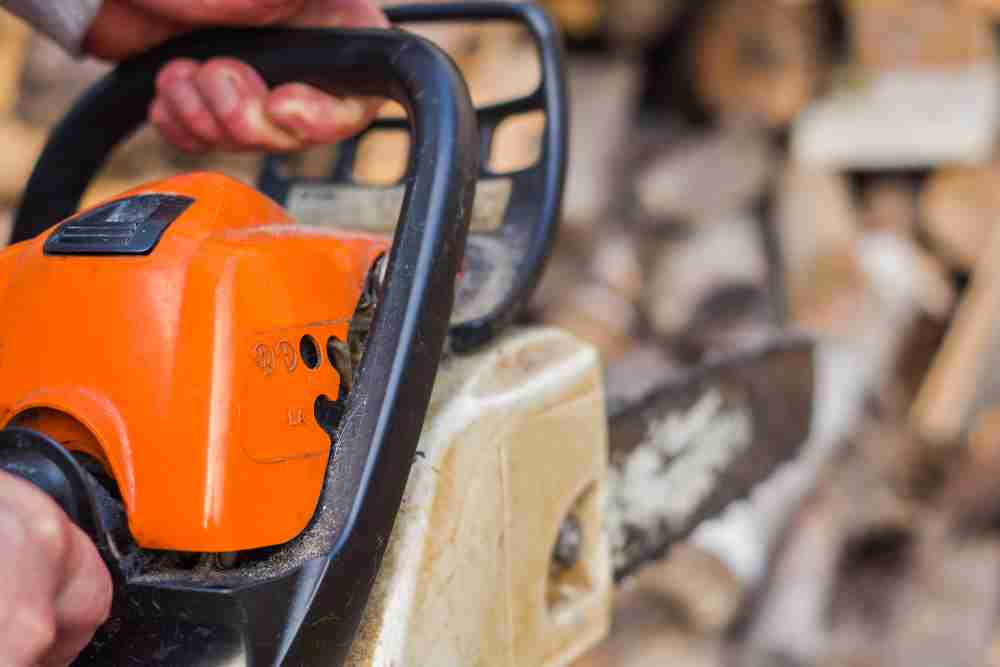To tighten a chainsaw blade, locate the tension adjustment screw and turn it clockwise until the chain is snug against the guide bar. A properly tightened chainsaw blade is crucial for safe and effective cutting.
Incorrect tension can result in a loose or binding chain, reducing cutting performance and increasing the risk of accidents. To ensure optimal blade tension, find the tension adjustment screw, typically located near the guide bar. Turn the screw clockwise until the chain sits snugly against the guide bar.
Avoid overtightening, as this can damage the chain or bar. Regularly check and adjust the tension as needed to enhance cutting efficiency and safety. By following these steps, you can easily tighten your chainsaw blade for effective woodworking applications.

How To Tighten Chainsaw Blade
1. Assessing The Condition Of The Chainsaw Blade
Assess the condition of your chainsaw blade by checking for visible signs of wear and tear. Inspect the tension of the chain to ensure it is properly adjusted. Examine the sharpness of the blade by running your finger along the cutting edge.
If it feels dull or rough, it’s time to sharpen it. To tighten the chainsaw blade, locate the tension adjustment screw and turn it clockwise until the chain is snug against the guide bar but still able to be rotated by hand.
Test the tightness by gently pulling on the chain, it should not droop from the guide bar. Regularly assessing and tightening the chainsaw blade will help maintain its cutting performance and prolong its lifespan. Keep safety in mind and always wear protective gear when working with a chainsaw.
2. Preparing For The Tightening Process
To prepare for tightening the chainsaw blade, gather the necessary tools and materials. Ensure the chainsaw is turned off and disconnected before beginning the process. Also, take safety precautions by wearing protective gear to prevent any potential accidents. Keeping these guidelines in mind will help you start the tightening process smoothly and safely.
3. Adjusting The Tension Of The Chainsaw Blade
Properly adjusting the tension of your chainsaw blade is crucial for optimal performance. Locate the tensioning mechanism on your chainsaw, usually found near the blade. Understanding the correct tension for the blade is essential; it should be tight enough to prevent it from slipping off, but not too tight to restrict movement.
To adjust the tension, use the appropriate tool specified by the manufacturer. Insert the tool into the tensioning mechanism and turn it until the desired tension is achieved. Be sure to check the tension regularly, especially before each use, as it can loosen over time.
By following these steps and maintaining the proper tension, you can ensure a safer and more efficient chainsaw operation.
4. Testing The Tightness Of The Chainsaw Blade
To ensure the chainsaw blade is tight, perform a visual check on the tensioning mechanism. Next, try moving the chainsaw chain manually to verify its tightness. Pay attention to any abnormal noises while operating the chainsaw. These steps will help maintain the chainsaw’s performance and prevent accidents.
Regularly checking the blade’s tightness is crucial for safe and effective chainsaw operation. Proper tensioning ensures that the blade remains secure during use, reducing the risk of kickback and other hazards. By following these guidelines, you can ensure a tight chainsaw blade for optimal performance and safety.
Don’t forget to regularly inspect and tighten the chainsaw blade to keep it in top condition. Remember, safety should always be your top priority when working with chainsaws.
5. Maintaining The Proper Tension
Developing a regular maintenance schedule for the chainsaw is crucial in ensuring its efficient performance. To tighten the chainsaw blade, it is important to check the tension before each use. By doing so, any issues or potential problems can be identified and resolved promptly.
Continuously monitoring the condition of the chainsaw blade is equally vital in maintaining its optimal tension. Regular inspection for any signs of wear or damage allows for immediate action to be taken, preventing further complications. Staying proactive with maintenance and being attentive to the chainsaw’s tension will contribute to its smooth operation and longevity.
Regular check-ups and adjustments will keep the blade tight and ready for use whenever needed. By adhering to these practices, you can ensure the safe and efficient functionality of your chainsaw.
6. Troubleshooting Common Issues
Chain slipping or coming loose is a common issue that can be addressed while tightening chainsaw blades. Excessive tension on the chain should also be dealt with accordingly. In case you are unable to resolve these problems on your own, it is recommended to seek professional help.
Remember to follow these troubleshooting tips for a smoother chainsaw operation.
FAQs
Can You Tighten A Chainsaw?
Yes, you can tighten a chainsaw for better performance and safety.
What Happens If Chainsaw Is Too Loose?
If the chainsaw is too loose, it can lead to safety risks, including kickback and poor cutting performance. Regular tightening is necessary to ensure proper function.
Why Is My Chainsaw Blade So Loose?
Your chainsaw blade may be loose due to improper installation or wear and tear on the chain tensioner.
How Do You Tighten A Stihl Chainsaw Blade?
To tighten a Stihl chainsaw blade, follow these steps: 1. Turn off the chainsaw and make sure it is cool. 2. Use a wrench to loosen and remove the nuts holding the chain cover in place. 3. Adjust the tension by turning the tensioning screw clockwise to tighten the chain or counterclockwise to loosen it. 4. Once tightened, ensure the chain is properly aligned with the guide bar. 5. Replace the chain cover and tighten the nuts securely. 6. Check the chain tension periodically to ensure safe operation.
